Used Nissan Altima Quick Facts
- 2022 and newer are the best years to buy a used Nissan Altima.
- Over the years, the Altima’s fuel economy has been one of its best attributes.
- The Altima has been a coupe, a hybrid, and even a performance sedan during its history.
In the trifecta of Japanese family sedans, the Nissan Altima usually places a tight third behind the Honda Accord and the Toyota Camry. Like its more popular rivals, the Altima has a decent reliability history, exceptional build quality, and frugal fuel consumption.
While it may not always be as cutting-edge as the competition, the Nissan Altima is a stylish and sporty family sedan offered at a good price. If you are seeking a comfortable sedan that is safe, roomy, and affordable, a used Altima will probably do the trick.
- What Is the Best Model-Year Used Nissan Altima?
- Nissan Altima by Generation: Which Should You Buy?
- Should You Buy a Used Nissan Altima?
- Is the Nissan Altima Reliable?
- Used Nissan Altima Model Years to Avoid
- Does the Nissan Altima Hold Its Value?
- Does the Nissan Altima Come in Coupe or Wagon Form?
- What Kind of Gas Mileage Does the Nissan Altima Get?
What Is the Best Model-Year Used Nissan Altima?
The best bet on a used Nissan Altima is one of the sixth-generation cars, preferably a 2022 or newer model. This version is the most up-to-date Altima, with far better quality and features than the generations before it. The sixth-generation Altima offers a choice of engines and drivetrains, including a potent turbocharged engine and all-wheel drive (AWD).
If you’re on a tight budget, a fifth-generation Altima from 2015 through 2018 is a good second choice, especially the higher trims. These cars come nicely equipped yet won’t cost much more than a used base model.
Enthusiasts on a budget might like the fourth-generation (2008-2011) Altima, which offers a 270-horsepower V6 engine and a 6-speed manual transmission. However, as these models are getting up in age and mileage, be sure to do your homework and have a reputable mechanic look the car over before purchasing.
See used Nissan Altima cars for sale near you
Nissan Altima by Generation: Which Should You Buy?
Sixth Generation: 2019-Current
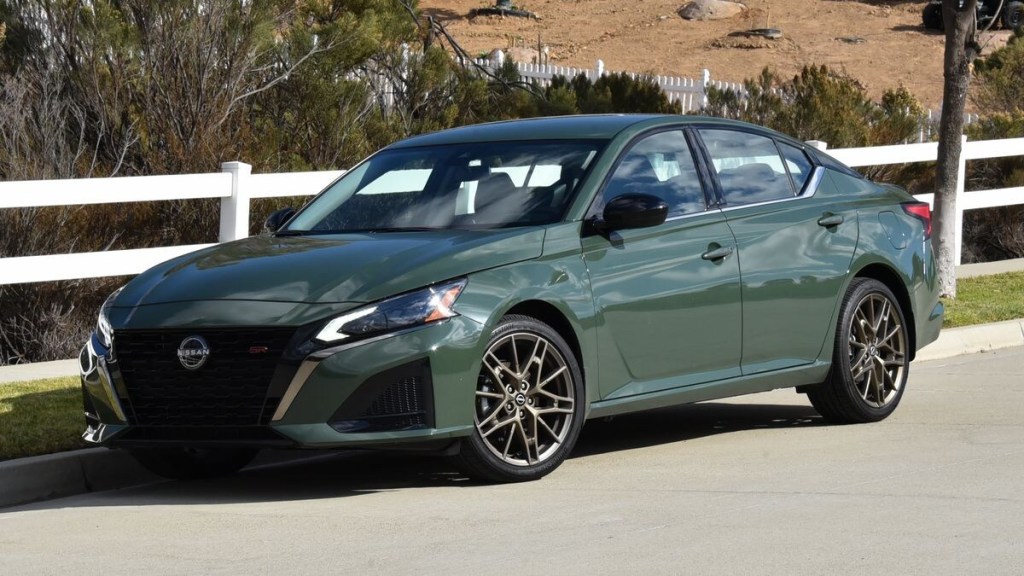
The sixth-generation Altima is by far the best choice for a used Nissan sedan. It ditches the previous generation’s V6 for a more modern turbocharged 4-cylinder that’s as quick as it is fuel-efficient. The continuously variable automatic transmission (CVT) remains, but Nissan has been building it for so long that they’ve finally gotten the formula down pat, even if it still sounds a bit coarse.
The Altima comes in several trims. The S, SV, SL, SR, and Platinum all use the same 188-hp 2.5-liter engine. Optional on the SR and Platinum trims is the 248-hp 2.0-liter turbo. S, SV, and SL trims with the 2.5-liter engine offer the option of all-wheel drive (AWD).
The least expensive S trim has 16-inch steel wheels with plastic covers, air conditioning, power windows and door locks, keyless entry with push-button start, an 8-way power driver’s seat, and an 8-inch touchscreen infotainment system with NissanConnect apps, Apple CarPlay, and Android Auto. Standard driver assists are limited to forward collision warning and automatic emergency braking.
The SR and SV are better choices, bringing more features and better driver-assist systems. The SR adds a sporty touch, with 19-inch wheels, LED headlights, and a sport-tuned suspension.
The SV rides on smaller 17-inch wheels but adds heated front seats, a heated steering wheel, dual-zone automatic climate control, a power moonroof, and rear seat air vents.
Nissan Safety Shield 360 (optional on the SR) adds a blind-spot monitor, rear cross-traffic detection and braking, lane departure warning, and automatic high-beam headlights. ProPilot Assist brings adaptive cruise control and lane-centering.
The SL goes further, with leather upholstery, voice-recognition navigation, a Bose sound system, a power passenger seat, and traffic sign recognition.
The Platinum includes all the SL features, driver’s seat memory, a 360-degree monitor, and 19-inch alloy wheels.
As this generation is still relatively new, you might want to consider buying a certified pre-owned (CPO) model. CPO status comes with a thorough inspection and increases the powertrain warranty to seven years or 100,000 miles from when the vehicle first entered service.
For the most part, this generation is reliable. There are some reports of windshields that crack easily, overly sensitive forward collision and braking settings, and issues with the CVT later fixed with a software update. There’s an ongoing investigation into the 2.0-liter turbo engines due to problems with failing connecting rod bearings. There have also been a few recalls, with the 2019 model having the most. You can see a complete list of recalls and complaints by visiting the National Highway Traffic Safety Administration website.
Model-Year Changes:
2025: Nissan drops the 2.0-liter turbo engine.
2024: No significant changes.
2023: The Altima gets revised styling and some new features. A 12.3-inch touchscreen is standard on the SR and SL and optional on the SV. The Platinum trim disappears.
2022: No significant changes exist besides some upgraded trim package features.
2021: The Platinum trim loses the 2.0-liter turbo, the SR moves above the SV trim, and new options for the S include a blind-spot monitor, rear cross-traffic alert, rear automatic braking, and rear parking assist.
2020: The S trim offers the option of Safety Shield 360, which is now standard on the SR.
See 2019-to-current Nissan Altima cars for sale near you
Fifth Generation: 2013-2018
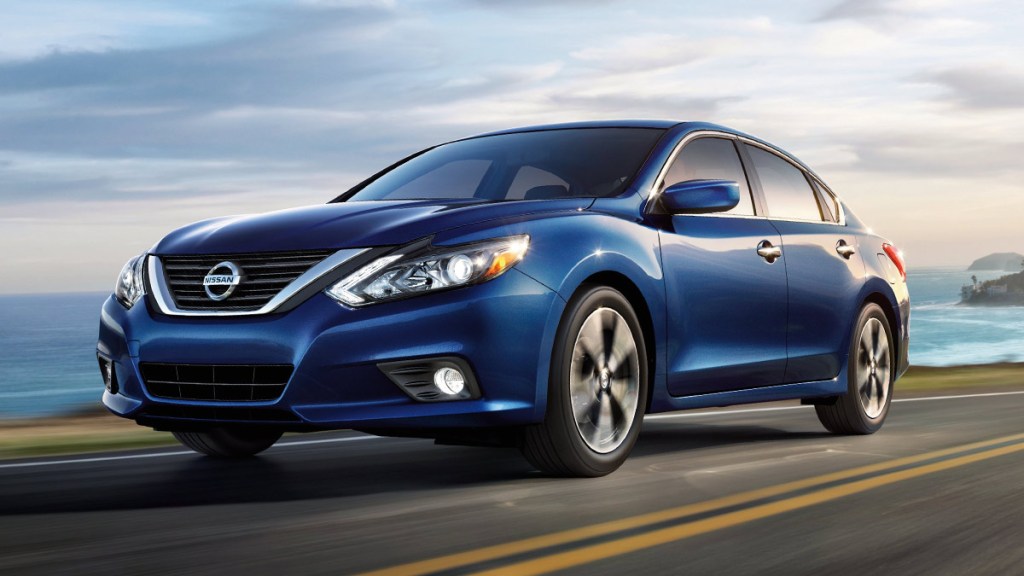
The fifth-generation Altima has a quieter cabin, more technology, and better crash test scores. This generation is the first to add features like advanced driver assists and smartphone connectivity. The coupe and hybrid models don’t make the leap, nor does the manual transmission option.
Although much of the mechanical and suspension parts carry over from the last generation, this version takes on a more radical look, mimicking the Maxima sedan and the Murano SUV. By this point in the Altima’s timeline, rivals such as the Honda Accord, Hyundai Sonata, and Toyota Camry are overtaking it in size, technology, and innovation.
One area in which the Altima continues to dominate is fuel economy, with the 2.5 models earning an estimated 38 mpg on the highway. The Altima’s interior is more luxurious, with better-quality plastics and Nissan’s NASA-inspired Zero Gravity seats. Other options include a heated steering wheel and a 9-speaker Bose sound system, as well as blind-spot detection and lane departure warning.
At launch, there are five trims: base, S, SV, and SL. The standard engine is a 182-hp 2.5-liter 4-cylinder, with a 270-hp 3.5-liter V6 optional, but only on the S, SV, and SL. All models use a continuously variable automatic transmission (CVT).
The base trim is rather sparse but has basics like power windows, power locks, manual air conditioning, Bluetooth, a push-button start, and a 4-inch LCD driver information display. The S adds auto on/off headlights, a power driver’s seat, and cruise control.
Moving to the SV brings more upgrades, like 17-inch alloy wheels, a USB iPod port, a rearview monitor, and dual-zone automatic climate control. The SL brings luxury touches like leather upholstery, fog lights, driver’s seat power lumbar support, a Bose audio system, power mirrors, and a power moonroof. Options for the SL include navigation, a blind-spot monitor, and lane departure warning.
Some red flags for this generation center around excessive oil consumption for the 2.5-liter engine, issues with the CVT, and some recalls regarding leaky fuel pumps and airbags that might fail to deploy. The CVT is the biggest concern. Over the years, Nissan has made several changes to the design due to customer complaints. A CVT requires its fluid to be changed at least every 60,000 miles, but many high-mileage cars have never done it. Old or dirty fluid can lead to operational issues ranging from sluggish shifts to complete failure. We highly recommend having a qualified mechanic check over any used Altima hailing from this generation or older before buying.
Model-Year Changes:
2018: All models gain automatic emergency braking and forward collision warning. The 3.5 SL gains adaptive cruise control. Apple CarPlay and Android Auto join the optional equipment list.
2017: No significant changes.
2016: The Altima gets a significant makeover, a new SL trim, and a new Tech Package featuring forward collision warning, automatic emergency braking, and adaptive cruise control.
2015: Nissan drops the 3.5 S and SV, leaving only the 3.5 SL, which gains front and rear parking sensors. The SV trim gains an 8-way power driver’s seat.
2014: NissanConnect allows access to smartphone apps such as Pandora, iHeart Radio, and Google’s Online Search.
See 2013-2018 Nissan Altima cars for sale near you
Nissan Altima Early Years: Generations One Through Four
2007-2012, the Fourth Generation
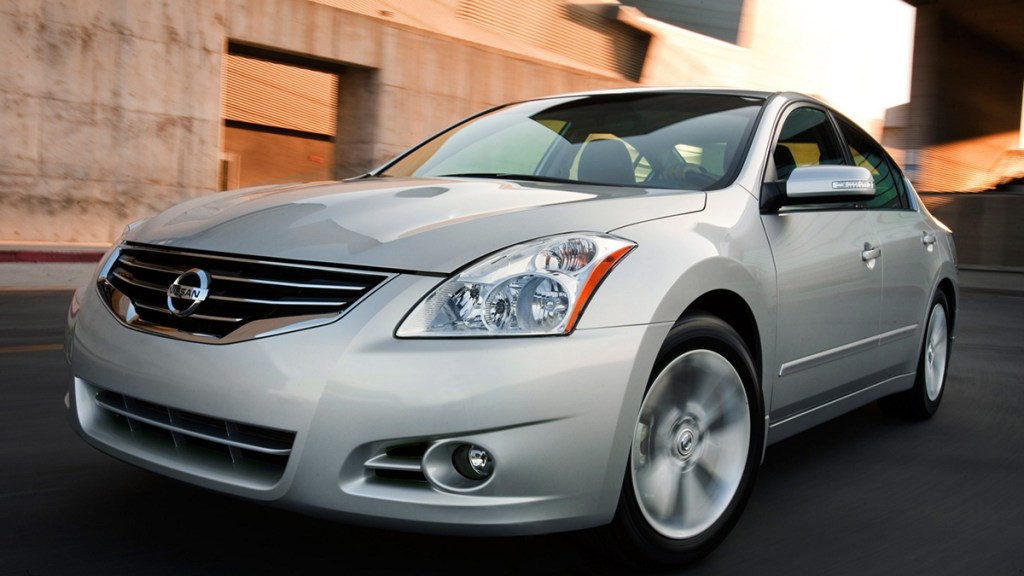
If you are seeking a low-priced Altima with modern safety and tech features, here is where you’ll find it. This generation is slightly shorter than the previous one, but passenger and cargo volumes remain unchanged. The fourth generation expands its offering, introducing a sporty coupe (2008-2013) and a hybrid model (2007-2011), although Nissan didn’t sell many hybrids as it limited sales to about 10 states. The bread-and-butter car remains the sedan, which sees improvements to the engine, suspension, and seats. Trims are renamed 2.5, 2.5 S, 3.5 SE, and 3.5 SL. Engine choices remain the same, only the 3.5-liter V6 elevates output to 270 hp.
New features for this generation of Altima included keyless entry and push-button start, an available rear-view camera, Bluetooth cell phone connectivity, and GPS navigation. Sadly, Nissan axed some of these features after the 2008 model year. Standard anti-lock disc brakes arrived in 2008, and the previously optional VDC traction became standard in 2010. The fourth-generation Altima is also the first to offer a CVT automatic transmission, which improves fuel economy but not performance or reliability.
See 2007-2012 Nissan Altima cars for sale near you
2002-2006, the Third Generation
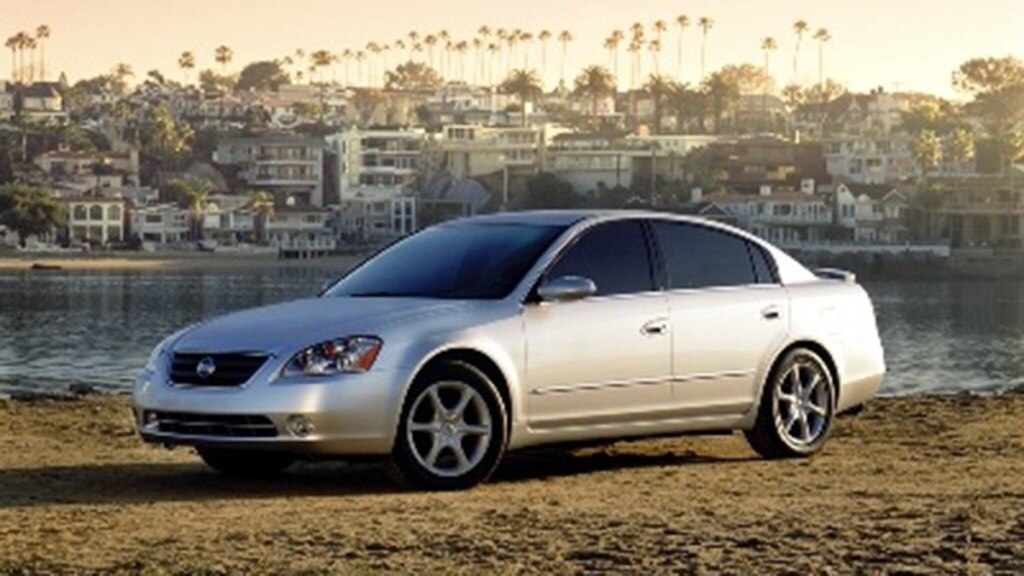
The third-generation Altima grows to become a proper midsize sedan, with a generous rear seat, better suspension, and an available V6 engine.
The third-gen Altima gains disc brakes on every wheel and a multilink rear suspension. Upper-end trims such as the SL and SE offer heated seats, Bose audio, a leather interior, and a key fob that allows the windows to be raised or lowered remotely. Front side-impact airbags and side-curtain airbags join the option list.
Power for this generation comes from either a 175-hp 2.5-liter 4-cylinder or a 260-hp 3.5-liter V6. The sporty SE-R trim has a V6, a 6-speed manual transmission, performance brakes, and a larger wheel and tire combo. At the time, the car was said to clock a zero to 60 mph time of around 6 seconds. That’s darn quick even by today’s standards. This generation holds up well for the most part, although it does see an issue with excessive oil consumption on early versions of the 2.5-liter engine and some rusting floorboards in some years.
See 2002-2006 Nissan Altima cars for sale near you
1993-2001, the First and Second Generations
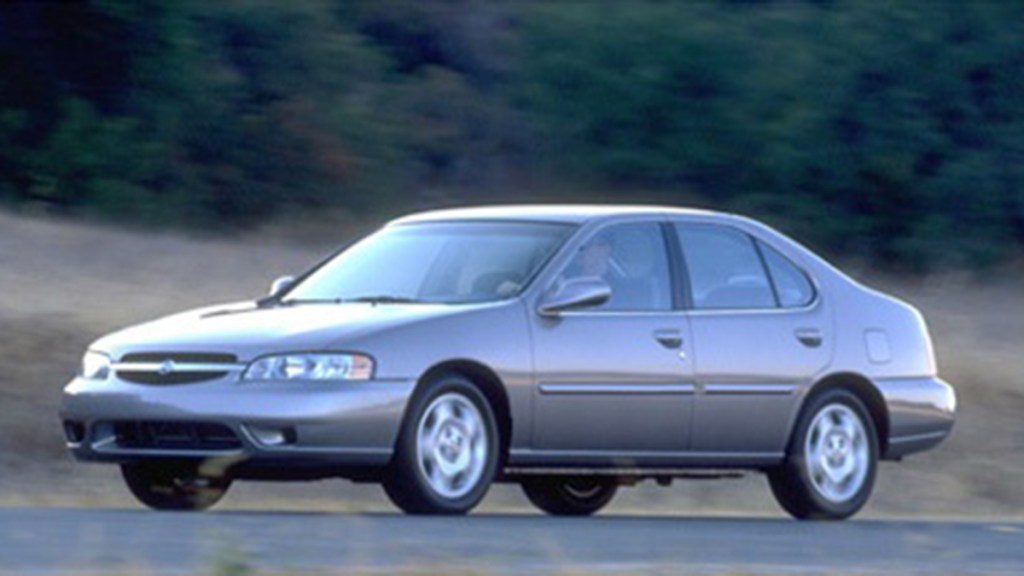
The Altima’s life began as a small sticker placed next to the Stanza badge on Nissan’s midsize family sedan. That was in 1993, but by 1994, the Stanza name was gone, heralding in the Altima as Nissan’s middle child. Slotting between the compact Sentra and the upscale Maxima, the first- and second-generation Altima ran from 1993-1997 and 1998-2001, respectively. A 2.4-liter 4-cylinder engine powers both generations. Nissan offered a few trims, running from basic XE to the luxury GLE. The sporty SE trim features white-faced gauges, body-colored trim, and bigger wheels.
See 1993-2001 Nissan Altima cars for sale near you
Should You Buy a Used Nissan Altima?
A used Nissan Altima isn’t a bad choice, especially if we’re talking about the fifth and sixth generations. It offers a roomy interior, good safety and crash test scores, lots of high-tech features, and a reasonably good resale value. For older Altima models, the main things to have checked are the condition of the continuously variable automatic transmission (CVT) and oil consumption issues on the 2.5-liter engine.
Is the Nissan Altima Reliable?
The Altima holds up pretty well despite the issues we’ve already mentioned. Late-model Altima sedans are free from rust issues or major electrical and safety defects. If the previous owner has kept up with all the maintenance and service requirements, odds are a used Altima will serve you well. However, like all cars, there will always be minor issues. For the major ones, you can see all the Altima’s recalls by visiting the National Highway Traffic Safety Administration website.
Used Nissan Altima Model Years to Avoid
While no major red flags exist for any specific model year, those with the most issues and complaints are 2015-2018 (fifth generation) and 2019-2021 (sixth generation). Older Altima cars also seem to have some issues with the CVT’s operation and excessive oil consumption from the 2.5-liter engine. Again, this is not something every Altima will suffer, but it is worth having the vehicle inspected by a certified mechanic before you buy.
Does the Nissan Altima Hold Its Value?
The Altima has slightly above-average resale values, more so for the newer sixth-generation cars. Its 5-year values are nowhere near those of the Honda Accord, the Hyundai Sonata, or the Toyota Camry, but they are on par with the Ford Fusion, the Volkswagen Jetta, and the Chevrolet Malibu.
RELATED: Best Honda Accord Years to Buy Used
Does the Altima Come in Coupe or Wagon Form?
Except for the fourth-generation coupe, the Altima is a sedan-only affair.
What Kind of Gas Mileage Does the Altima Get?
Over the years, the Altima’s fuel economy has been one of its best attributes. In a non-hybrid world, it generally leads the midsize sedan group, with city and highway fuel economy estimates at or near the top of its class.
RELATED: Best Toyota Camry Years to Buy Used











